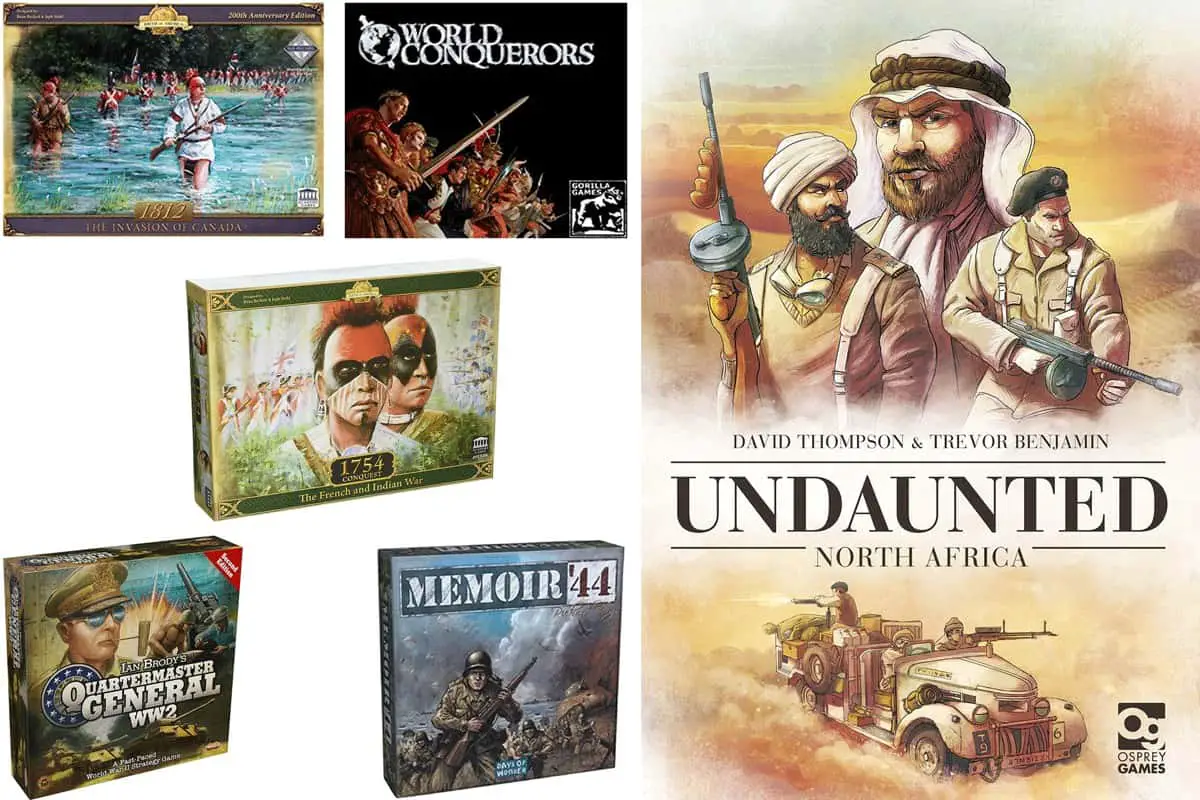This post contains affiliate links.
War games can be complex and long to play, but here I introduce you to a list of simplified wargames that can help develop children’s critical and strategic thinking skills, or just be used as family games.
These 6 family-friendly board games are inspired by wars dating from the 18th century to modern times. The war scenarios included territorial claims in North America, North Africa, and Europe.
Most of the war games in this list use cards to launch an attack, dice rolls in combat, and cubes to mark the territories on the gameboard.
War Games Comparison Table
This table will help you quickly identify each game’s age recommendation and player count.
| Game | Age | Players | Price | Rating |
|---|---|---|---|---|
| 1754 Conquest: The French and Indian War | 12+ | 2-4 | $$$$ | ★★★★☆ |
| 1812: The Invasion of Canada | 12+ | 2-5 | $$$$$ | ★★★☆☆ |
| Days of Wonder Memoir ‘44 | 12+ | 2-8 | $$$$ | ★★★★☆ |
| World Conquerors | 10+ | 1‑4 | $$$ | ★★★☆☆ |
| Quartermaster Generals | 12+ | 2‑6 | $$$$ | ★★☆☆☆ |
| Undaunted: North Africa | 14+ | 2 | $$$ | ★★★★★ |
1754 Conquest: The French and Indian War (Academy Games)
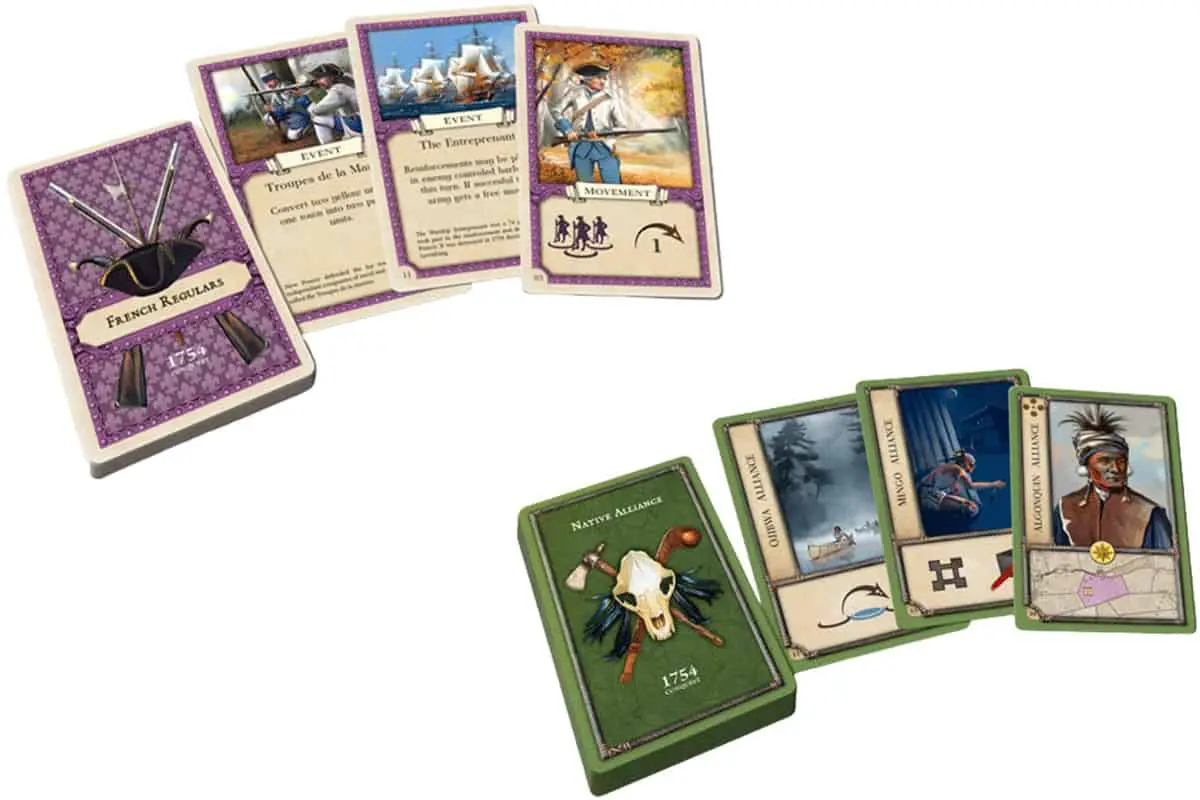
★★★★☆
For Families | Age: 12+ | 2-4 Players | Game Duration: 1-2 hours | Designer: Beau Beckett and Jeph Stahl
In 1754: Conquest- The French and Indian War, players can reenact the battle fought by Great Britain and France over the control of Ohio Valley in 1754.
players can reenact the battle fought by Great Britain and France over the control of Ohio Valley in 1754.
This war game depicts the expansion of territorial claims to the West of Ohio by the British empire while the French counter these advances by building a chain of forts. Various Native American tribes supported both factions.
Hence, in this game, players choose to represent a faction in the war. The color-coded wooden cubes represent the following factions:
- British army (red)
- French (purple)
- British colonials (White)
- French Canadians (yellow)
- Native Americans (green)
Players use movement cards and special cards to determine the actions in the game. Each faction has specific dice which differentiate their fate in the battle. Each die has a unique combination of “hit,” “flee,” and “command” faces.
For example,
- The French die has a side that hits opponents 50 % of the time, and it has a blank face that enables the French to retreat armies, but they can never flee.
The good thing about “fleeing” ability is they can re-enter the active play and show up anywhere on the gameboard. However, native fled units can be used only if an event card summons them.
I like that:
- This game explains real events in the rulebook
- The gameplay is asymmetrical (each faction has strengths and weaknesses limited by dice symbols)
- Dice roll keeps the game exciting and unpredictable
- Forts are powerful, which makes this game different from 1812: The Invasion of Canada
- Native Americans can alter strategies and the direction of the game
Although this game is competitive and takes about 1-2 hours, I recommend playing this game to ninth graders (the game would complement “US History 1”) at home as a supplemental activity. The game experience can enrich what they study at school. But you can, of course, play this game before, starting for example with 12-Year-old children.
by Tom Vasel, Dice Tower Review
1812: The Invasion of Canada (Flat River Group)
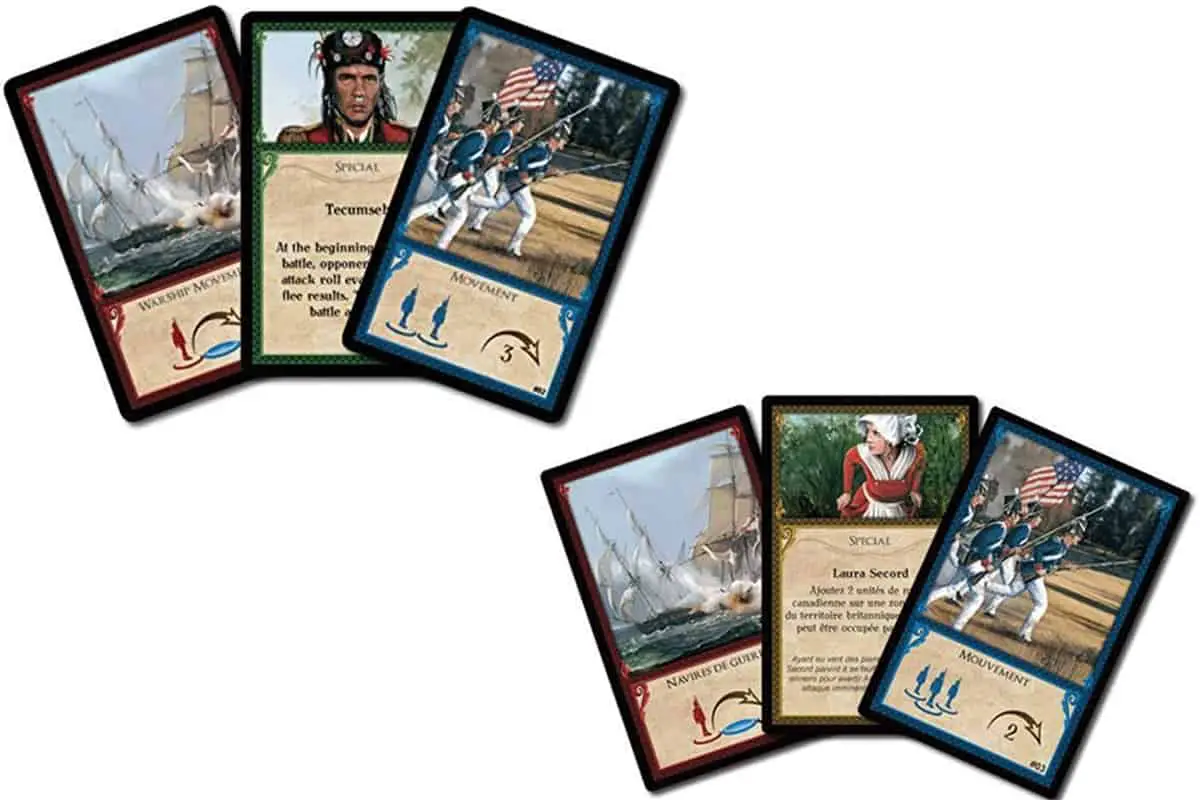
★★★☆☆
For Families | Age: 12+ | 2-5 Players | Game Duration: 1-2 hours | Designer: Beau Beckett and Jeph Stahl
1812: The Invasion of Canada follows the historical period where Great Britain seized American ships and goods to prevent the United States from trading with France and its allies. This embargo prompted the United States to declare war on Great Britain and invade Canada in 1812.
follows the historical period where Great Britain seized American ships and goods to prevent the United States from trading with France and its allies. This embargo prompted the United States to declare war on Great Britain and invade Canada in 1812.
It is a three-on-two battle where American Regulars and American militia opposed Canadian, British Regulars, and Native Americans. They fight to claim victory spots that are scored differently.
To win in this game, players aim to have the greatest number of control flag markers.
Just like 1754: Conquest- The French and Indian War, the wooden cubes are color-coded, and they represent the following factions:
the wooden cubes are color-coded, and they represent the following factions:
- British Regulars (red)
- Canadian Militia (yellow)
- Native American (green)
- American Regulars (blue)
- American militia (white)
Each faction has specific dice that contain its strengths and weaknesses. For example,
- British Regulars roll two dice per battle. Hence, they have a higher chance to hit but are less likely to flee.
This game includes a large, mounted map board, 5 custom battle dice sets, 5 custom card decks, 160 wooden unit cubes, and a rulebook.
The pros of playing this game are:
- The gameboard has a historically accurate map, which is good for determining the regions in that period
- The setup is easy because there are cues on the gameboard
- It features three scenarios that give players gameplay options
- The rules are easy to follow
- There are surprise cards that can change the pace of the game
- It encourages cooperative play
The disadvantages are:
- It is best played with 5 players.
- It takes about 1-2 hours to play.
The War of 1812 is briefly taught in 7th grade but mostly part of 9th grade as part of “US History 1”. That is why I recommend playing this game at home for additional information and better recall.
By Tom Vasel, Dice Tower Review
Days of Wonder Memoir ‘44 (Days of Wonder)
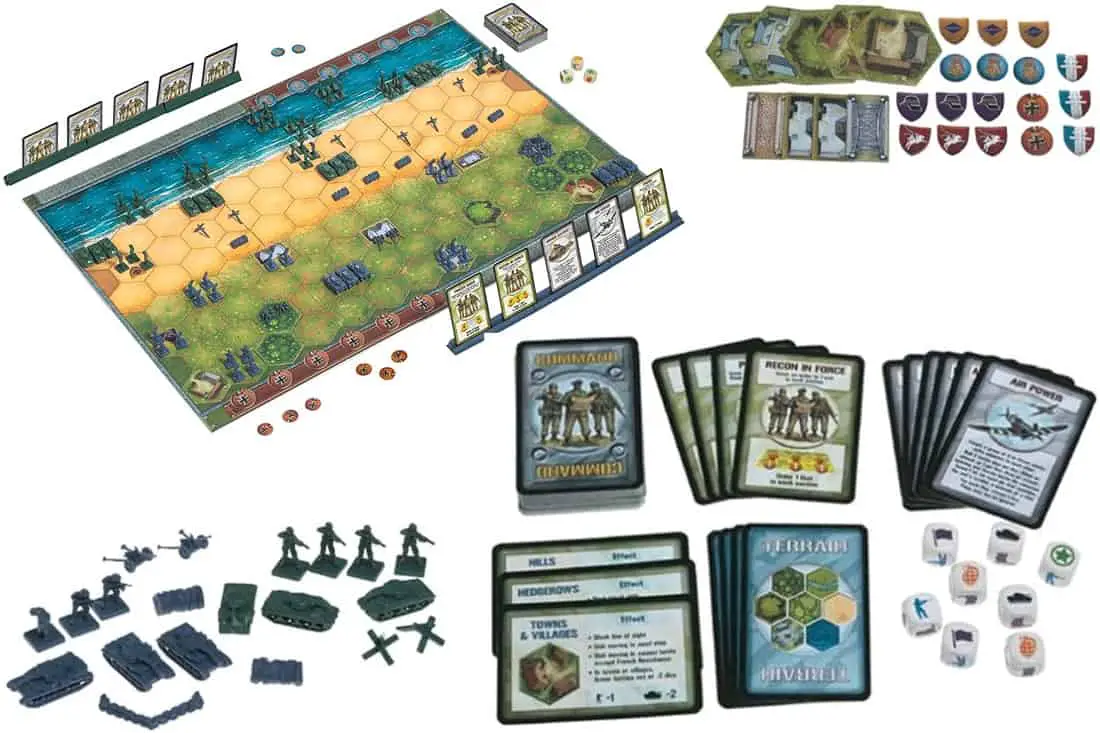
★★★★☆
For Families and Teachers | Age: 12+ | 2-8 Players | Game Duration: 30-60 minutes | Author: Richard Borg
Days of Wonder Memoir ‘44 features 17 historical battles on June 6, 1944, in Normandy, France.
features 17 historical battles on June 6, 1944, in Normandy, France.
Players choose one of these war scenarios and take a chance to change the outcome by leading their troops to victory either as an Axis player or an Allied player.
This game is typically played with 2 players, but it can also be enjoyed as a cooperative team play. It takes about 15-20 minutes to set up the double-sided gameboard, tiles, cards, miniatures, and tokens for each scenario.
Here are some reminders regarding the setup of the game:
- Each scenario has a different layout in the scenario booklet.
- The terrain tiles, shaped like hexes, are double-sided (represents forest, town, hills, bunkers, and hedgerows), so players will spend much time looking for the tiles that look close to the setup on the booklet.
- Players should pay attention to the symbols in the booklet because they must lay the miniatures according to the correct number and color of the pieces.
- Some spaces need badges, medals, and other special tokens.
- Each scenario has its own special rules and conditions to win the battle, but they are easy to learn.
In general, players use sections cards to issue units on the battlefield, while tactics cards provide instruction on which squad or team to move on the gameboard. The catch is teams move as a group and can be transferred to unoccupied hexes only.
I like the obstacles pieces (hedgehogs and wires) because the infantry can enter and exit without penalty when you put them on the board. On the other hand, artillery could move freely on the battlefield unless placed on bunkers.
The good points of this game are:
- The summary cards are placed on the side of the gameboard to assist players with rules during the game.
- The rulebook contains historical background and anecdotes
- Moving the miniatures on the battlefield is exciting, like chess (Children will enjoy this part!)
- The replay value is high because there are different ways to enjoy the game, such as:
- Apply a different strategy to the same scenario
- Players may switch sides but play the same scenario
- Alternate sides as players try all the scenarios
I am giving this game three stars because the sequence of play is rather overwhelming for young players, so adult supervision is encouraged.
I recommend playing this game with children in 6th-8th grade because the gameplay and components can help them visualize the events on D-Day. The 17 war scenarios will help them understand how Operation Overlord was executed.
By Rodney Smith – BoardGameGeek
World Conquerors (Gorilla Games)
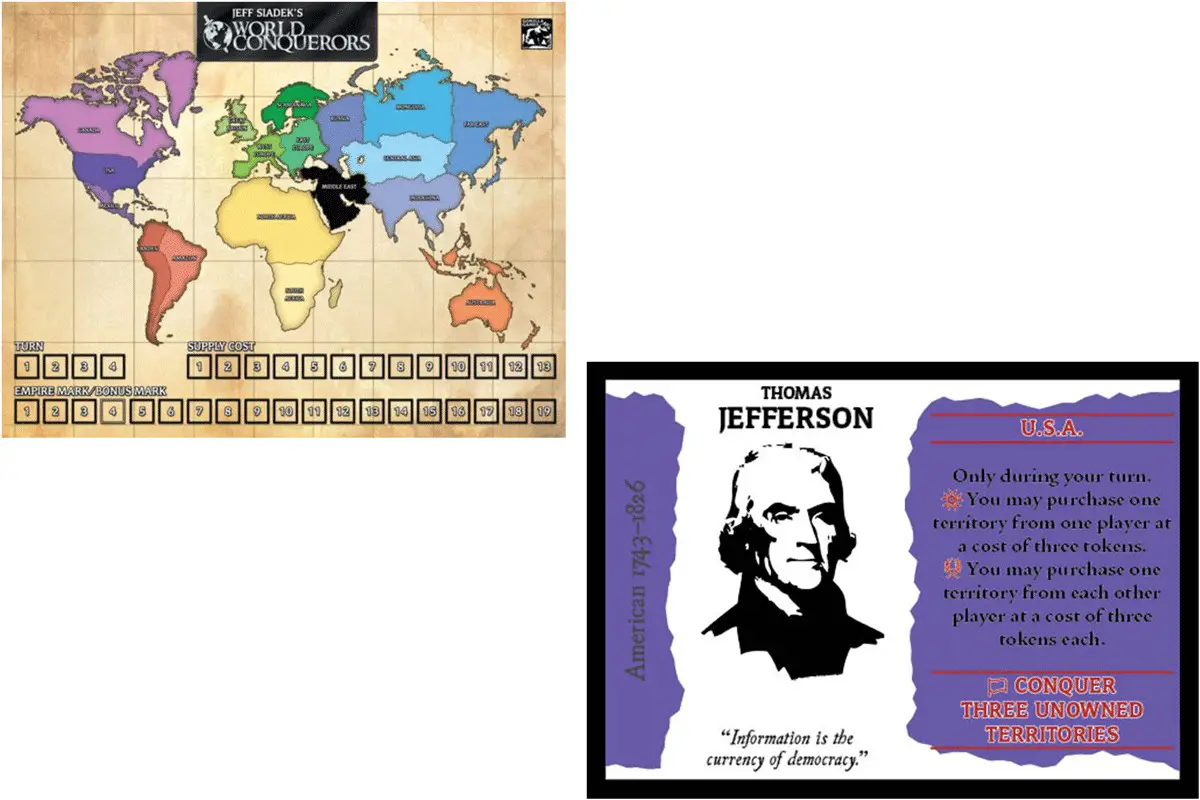
★★★☆☆
For Families | Age 12+ | 1-4 Players | Game Duration: 60-90 minutes | Designer: Jeff Siadek
In World Conquerors, players choose a world conqueror to lead their army and conquer territories. The player with the greatest number of acquired territories wins the game.
players choose a world conqueror to lead their army and conquer territories. The player with the greatest number of acquired territories wins the game.
This board game comprises a map board, deck of cards, cubes, pawns, beans, dice, and an 8-page rulebook.
At the start of the game, each player is given 3 ruler cards and six cubes according to their color.
Each card contains the following information:
- Name and image of the conqueror
- Territory
- Famous quote
- Special abilities
- Rewards for achieving the attack goal
Players have three options in using the cards.
- As a ruler– players roll the dice to determine the battle’s winner. The player with the highest rolled number wins the match.
- As a general – it forces the re-rolling of the die when placed in territories (Player places a pawn on the gameboard)
- As a special action card– players receive bonus points for carrying out the goal on the card.
On the other hand, the map contains:
- Supply cost track – indicates how many cubes a player pays the winner of the battle. It increases every time the player loses. If the player cannot match the cost, the player cannot launch an attack.
- Empire/ Bonus Track – tells the number of cubes that a player can gain
- Turn Track-each player has four turns to conquer a territory
The cubes are used:
- To represent armies
- as markers for territories conquered
- as payment for losing a battle
I like this game because
- It has an interesting mix of competent, terrible, and wicked leaders.
- Players can choose a different conqueror in each turn, and they won’t get eliminated even if they lose a match.
- It takes about an hour to complete the game.
I recommend playing this game because it can help children remember rulers like:
- Ashoka
- Adolf Hitler
- Catherine
- Caesar
- Genghis Khan
- George Washington
- Gustav II
- Napoleon
- Philip II
- Saladin
- Stalin
- And 39 more people.
By Tom Vasel – Dice Tower Review
Quartermaster General (Ares Games)
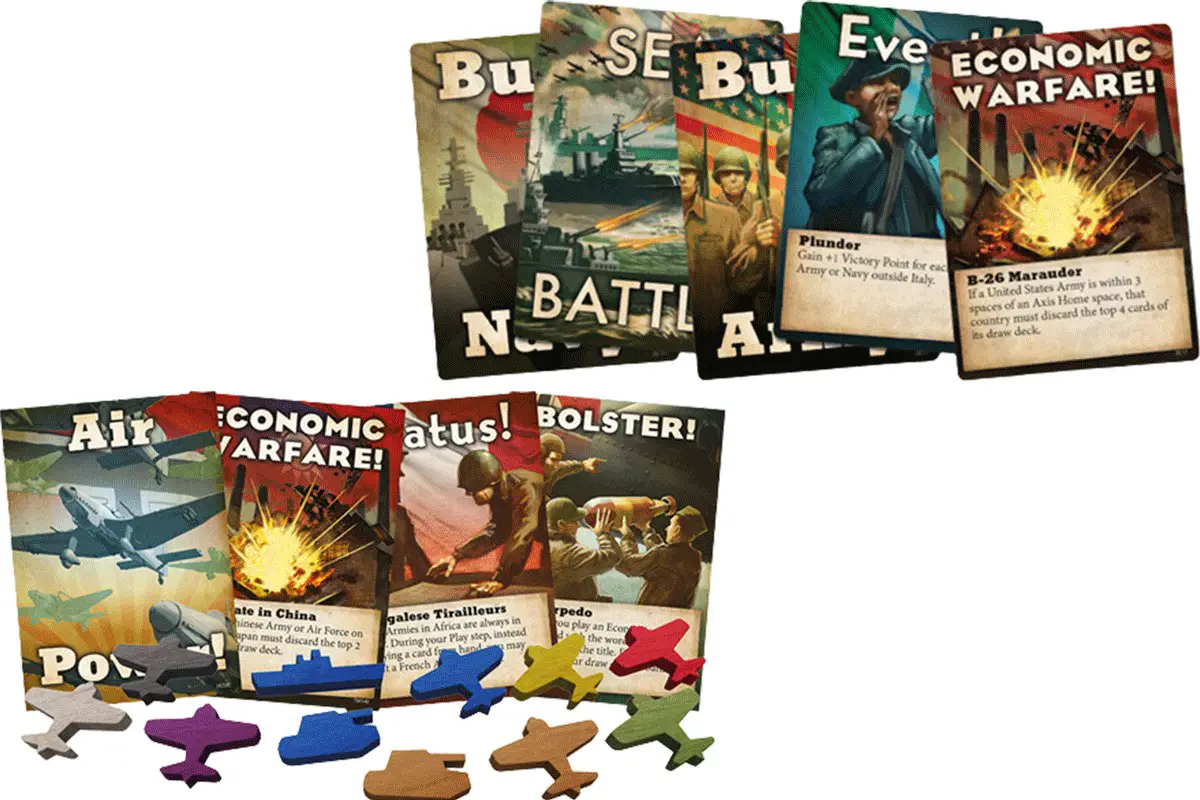
★★☆☆☆
For Families | Age 12+ | 2-6 Players | Game Duration: 90 minutes | Designer: Ian Brody
Quartermaster General is a card-driven game where players represent the Axis Powers (Italy, Japan, and Germany) or the Allied Powers (The US, the UK, and Russia) in building supply centers during World War II.
is a card-driven game where players represent the Axis Powers (Italy, Japan, and Germany) or the Allied Powers (The US, the UK, and Russia) in building supply centers during World War II.
Throughout 20 turns, players collect victory points by conquering territories to build and connect the supply zones on the gameboard. Starred territories score higher points. The player with the most points at the end of the game wins.
However, players may lose points if they are not careful in discarding cards (the US has the most cards, Italians have the least). Each country card deck has the following cards:
- Build Army
- Build Navy
- Land battle
- Sea battle
- Events
- Status (provides the special ability that can be used all throughout the game)
- Response (played face down, can be revealed if the prerequisite action has taken place)
- Economic Warfare (forces opponent to discard a card)
The pros and cons of this game include:
- It is best played with 2 players, but the game duration is shorter, and the turns are faster with more players.
- The design of the cards is not that stimulating, but the texts are reader-friendly
- Players can learn the rules faster when they play the game, but they might stop in the middle because they forget the special uses of the cards.
- Players forget to track victory points because their focus is on the cards to dispose of or use
Overall, this game has an interesting theme, but children might not find it exciting. That is why I am giving this game three stars.
By Tom Vasel, Dice Tower Review
Undaunted: North Africa (Osprey Games)
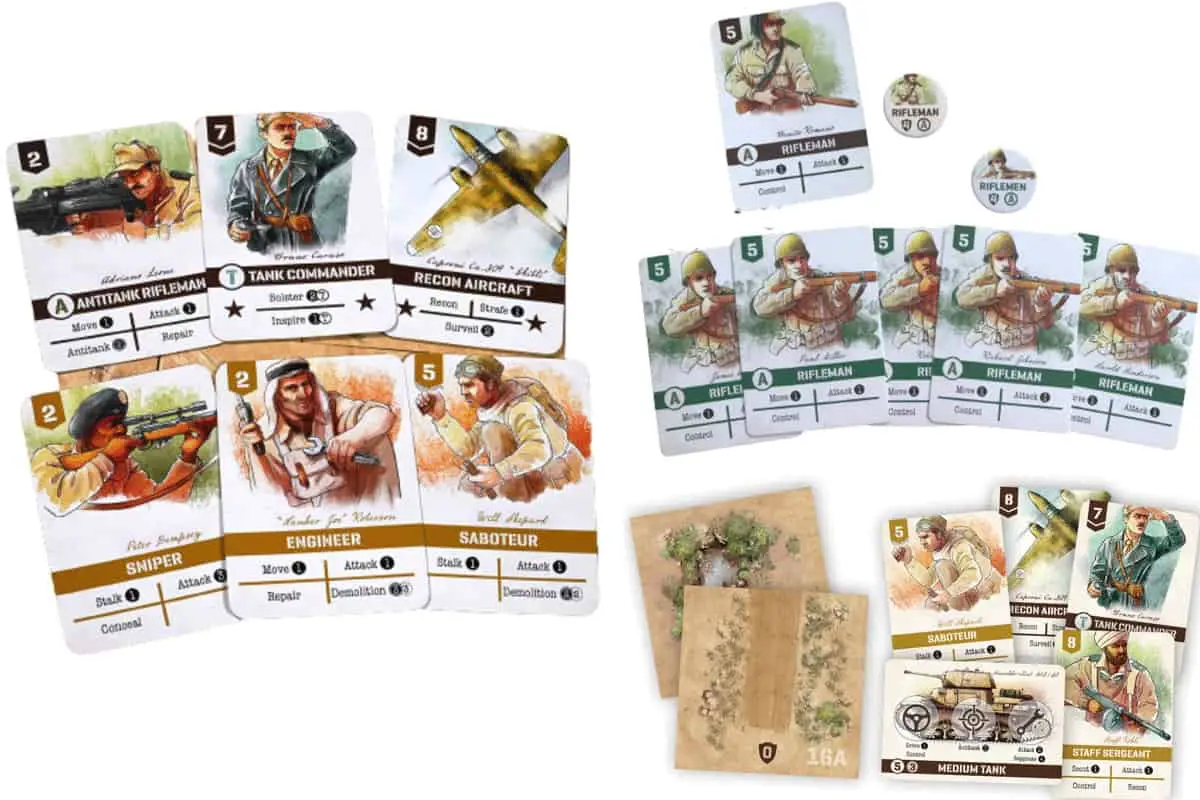
★★★★☆
For Families | Age 14+ | 2 Players | Game Duration: 45-60 minutes | Designer: Trevor Benjamin and David Thompson
Undaunted: North Africa was set in 1940 when the Royal Italian Army defended the country’s colonies in Africa against the British Army’s Long Range Desert Group (LDRG).
was set in 1940 when the Royal Italian Army defended the country’s colonies in Africa against the British Army’s Long Range Desert Group (LDRG).
This two-player tactical war game has 11 scenarios based on the exploits of LDRG. Each scenario has a different goal to win the game.
After choosing the scenario and the faction to represent, players set up the double-sided tiles according to the layout on the booklet.
Players have four cards in each round (one for the initiative, three to issue orders). Orders include moving soldiers, launching attacks, and grabbing objectives.
Compared to its predecessor, Undaunted: Normandy, this game has a few modifications such as:
- Each counter represents a single soldier, not a unit
- there are permanent death rules (for example, if a combat counter leaves the board, it is removed from the game permanently)
- Actions are more asymmetrical with the addition of vehicles (for example, the Italians may have a tank and air support that make it strong in some scenarios, while LDRG may have a “demolish” action card)
I like that:
- the rulebook is well-written
- the turns involve careful planning and decision-making (your opponent can kill your squad with dice rolls before you can put your team in a position to counter the attacks)
- The artwork is simple but thematic (the characters have the same drawing with big labels)
- It only takes about an hour to complete the game.
The game is fun and challenging, but it is not beginner-friendly because the shots are limited and need precision. I suggest playing this game a few rounds first with adult supervision or a partner.
Overall, I recommend playing this game at home as a supplemental activity for students in 8th-12th grade. This game can give them an idea about desert warfare during World War II.
By Tom Vasel, Dice Tower Review
Other Types of History Games
If you are interested in other history games, you might want to check my other posts:
- 5 Board Games That Teach Ancient History

- 14 American History Card Games and Flash Cards for Families and Schools

- 18 Card Games That Teach World History for Families and Schools

- 7 Art History Board Games for School and Home

- 20 Memory Games To Teach Art and Art History

Edudingo.com is a participant in the Amazon Services LLC Associates Program, an affiliate advertising program designed to provide a means for sites to earn advertising fees by advertising and linking to Amazon.com. We also participate in other affiliate programs which compensate us for referring traffic.

